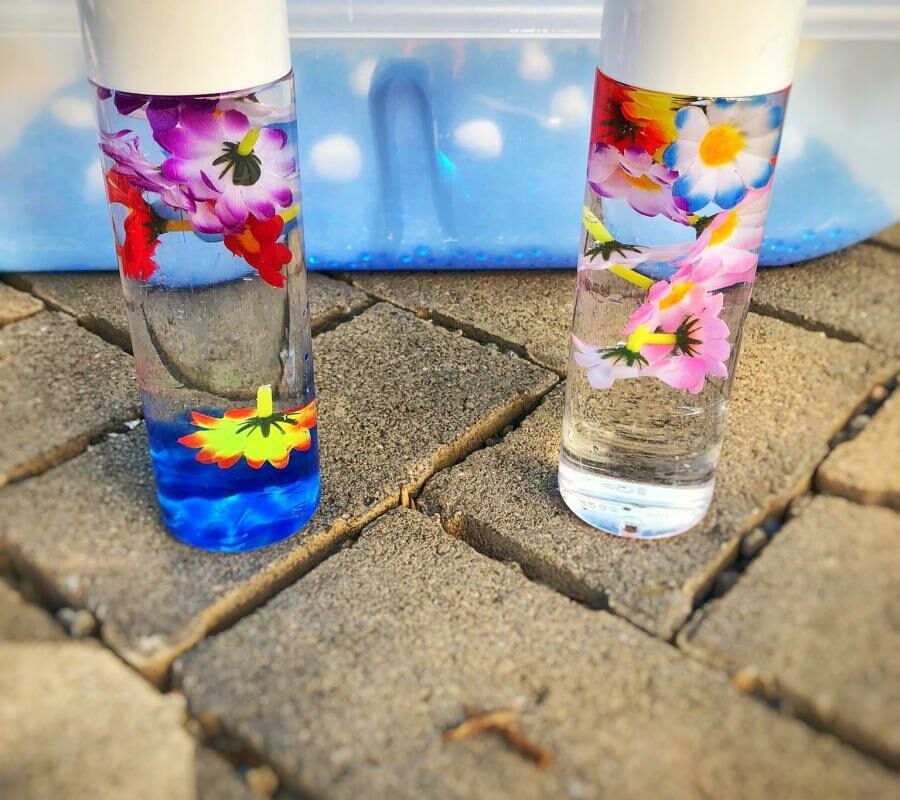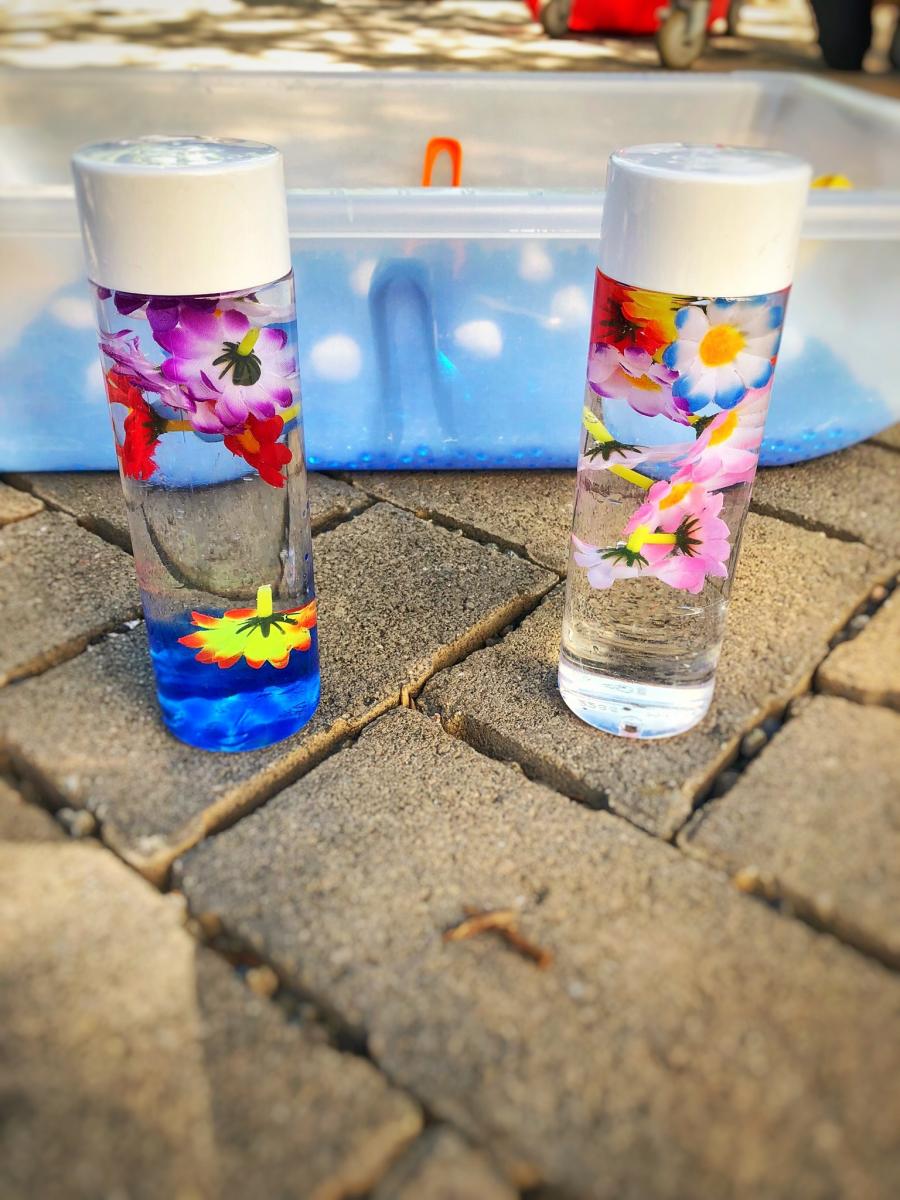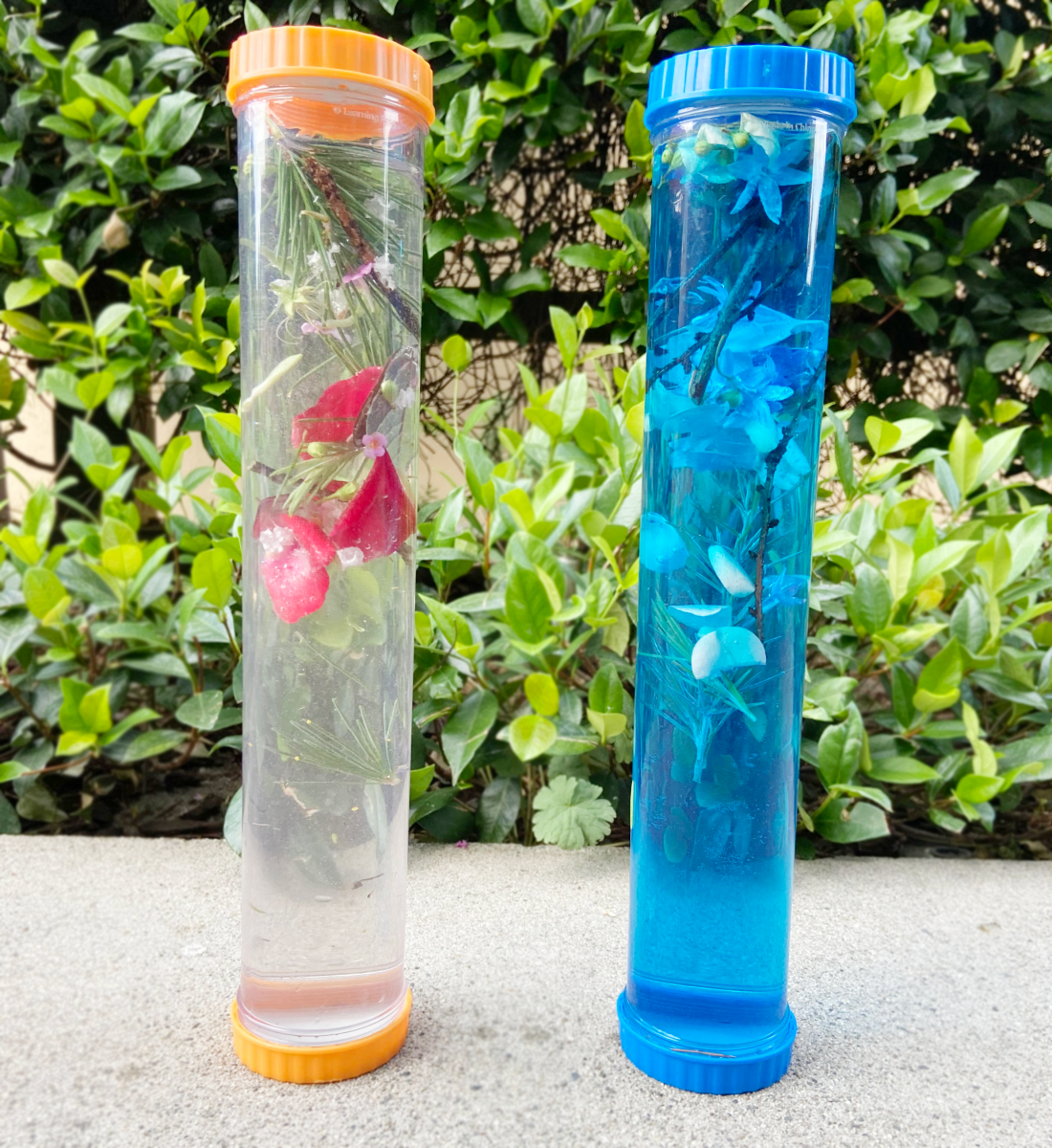Flower Sensory Bottle

I love making flower sensory bottles. It gives me the opportunity to go outside and explore nature around the museum while I look for my supplies. Collecting the actual supplies is what I enjoy most about this activity. It gives me the opportunity to touch, see, smell, hear, and manipulate the materials. As much as I love sensory play activities, they can tend to get messy. The sensory bottle offers the same benefits of a sensory bin, but without the mess. They are also easy to store, and you can use them anywhere (park, restaurant, store, car, etc.).

Objectives:
Sensory bottles are an easy way to stimulate senses while children explore the world around them. They help develop fine motor skills by developing and using small muscles by pouring water and collecting flowers, rocks, and sticks. Playing with a sensory bottle also supports cognitive development, problem-solving, creativity, and observation. Children can also improve their language skills and develop their vocabulary by asking and answering questions and using expressive language.
Basic Materials Needed:
Sensory bottles are easy to make. They can be created with any clear empty plastic bottle that has a lid and can use the following materials:
-
Water
-
Food coloring (optional)
-
Flowers, rocks, sticks, etc.
-
Water beads (optional)
Once you have gathered your materials, do the following:
-
Fill the plastic bottle with 1/4 inch to 1/2 inches of water beads.
-
Place flowers, rocks, and sticks in the bottle and add a few drops of food coloring.
-
Feel free to substitute other items from the outside (small rocks, glitter, oil, etc.).
-
Fill the rest of the bottle with water.
-
Make sure to secure the top with tape or hot glue so little hands cannot open it.
-
See picture as an example.
Now that you have assembled it you can play with the Flower Sensory Bottle. Let them enjoy the sensory-rich exploration of nature. Adults can enjoy making and using sensory bottles just as much as children can! You can support a child’s natural curiosity by asking prompting questions about their sensory bottle such as:
-
What do you see?
-
How do the flowers grow?
-
How many different colors can you find?
-
Why did you choose that flower, rock, or stick?
-
What else can you use to make your sensory bottle?
Have fun!
Botella sensorial de flores
Me encanta hacer botellas sensoriales de flores, me da la oportunidad de salir a explorar el museo y disfrutar encontrar y seleccionar los materiales necesarios. Me da la oportunidad de tocar, ver, oler, escuchar y manipular los objetos.
Este tipo de actividad se llama un juego sensorial. Esto es una actividad que estimula los sentidos y es importante para todos los niños durante las etapas de desarrollo. Una forma de abordar el juego sensorial sería a través de una botella sensorial. Este tipo de juego fomenta el desarrollo de las habilidades motoras y permite que los niños exploren, descubran, imaginen, creen y aprendan al mismo tiempo que involucran sus sentidos.
Por mucho que me encanten las actividades sensoriales, tienden a ser muy desordenadas o sucias. La botella sensorial ofrece los mismos beneficios que un contenedor sensorial, pero sin el desorden. También son fáciles de almacenar, y puede usarlos en cualquier lugar (parque, restaurante, tienda, automóvil, etc.)
Objetivos:
Las botellas sensoriales son una manera fácil de estimular los sentidos mientras exploran el mundo que los rodea. Ayudan a desarrollar las habilidades motoras finas al desarrollar y usar músculos pequeños al verter agua, recoger flores, rocas y palos. Jugar con una botella sensorial también apoya el desarrollo cognitivo, la resolución de problemas, la creatividad y la observación. Los niños pueden mejorar las habilidades del lenguaje desarrollando su vocabulario a través de preguntas y lenguaje expresivo.
Materiales básicos necesarios:
Las botellas sensoriales son fáciles de hacer. Se pueden crear con cualquier botella de plástico vacía y transparente que tenga una tapa y pueden usar los siguientes materiales:
-
Agua
-
Colorante alimentario (opcional)
-
Flores, rocas, palos, etc.
-
Perlas de agua (opcional)
 Una vez que haya reunido sus materiales, cree su botella sensorial de flores siguiendo los siguientes pasos:
Una vez que haya reunido sus materiales, cree su botella sensorial de flores siguiendo los siguientes pasos:
-
Llene la botella de plástico con perlas de agua de 1/4 a 1/2 pulgada. (opcional)
-
Coloque flores, rocas y palos en la botella y agregue unas gotas de colorante para alimentos.
-
Puede sustituir cualquier material (rocas pequeñas, purpurina, aceite, etc.)
-
Llene el resto de la botella con agua.
-
Asegure la parte superior con cinta adhesiva o pegamento caliente para que las manos pequeñas no puedan abrirla.
-
Vea la imagen como ejemplo.
¡No tengas miedo de participar!
Una forma de facilitar y apoyar la curiosidad de su niño sería haciendo preguntas. Tales como:
-
¿Qué ves?
-
¿Cómo crecen las flores?
-
¿Cuántos colores diferentes puedes encontrar?
-
¿Por qué elegiste esa flor, roca o palo?
-
¿Qué más puedes usar para hacer tu botella sensorial?
¡¡Que te diviertas!!
